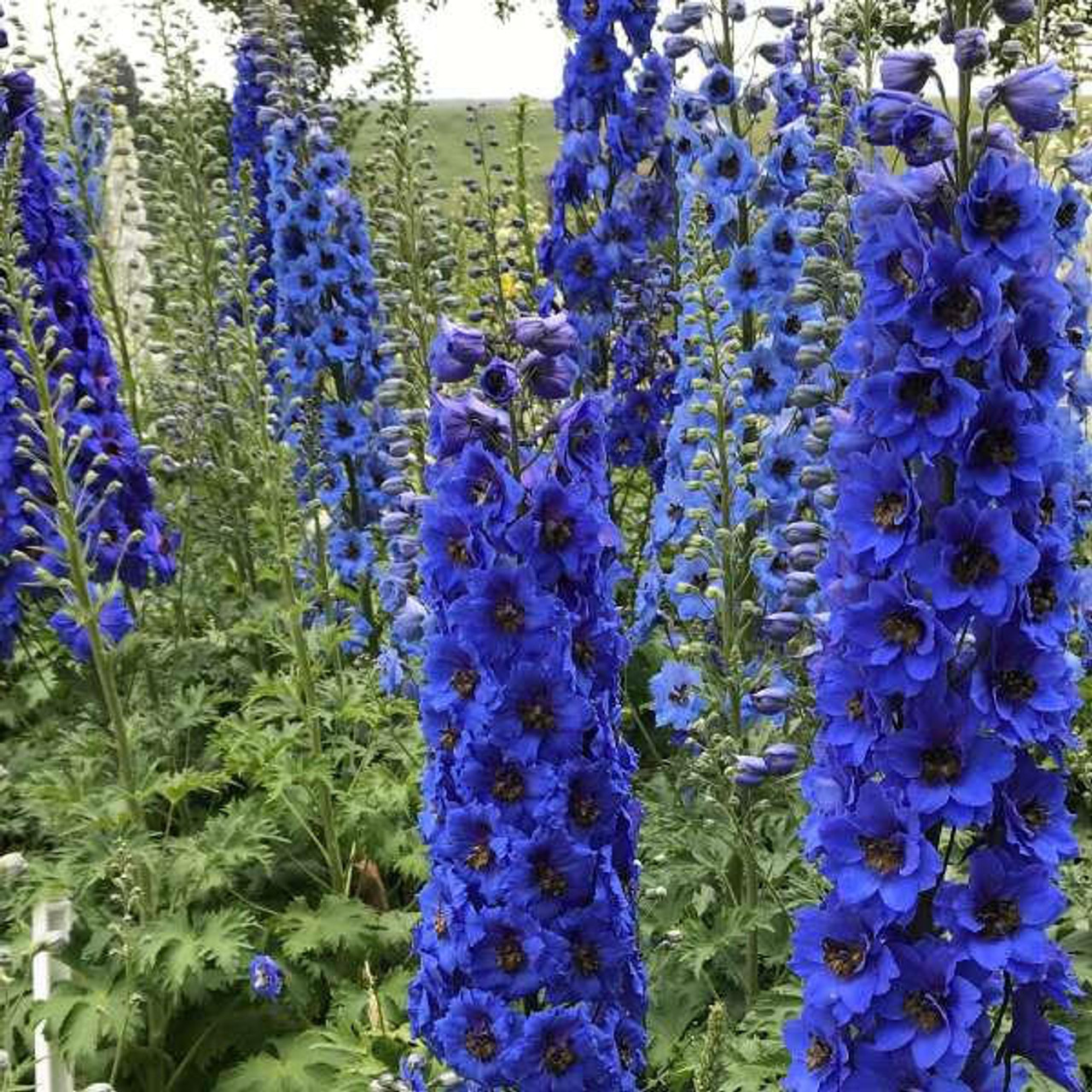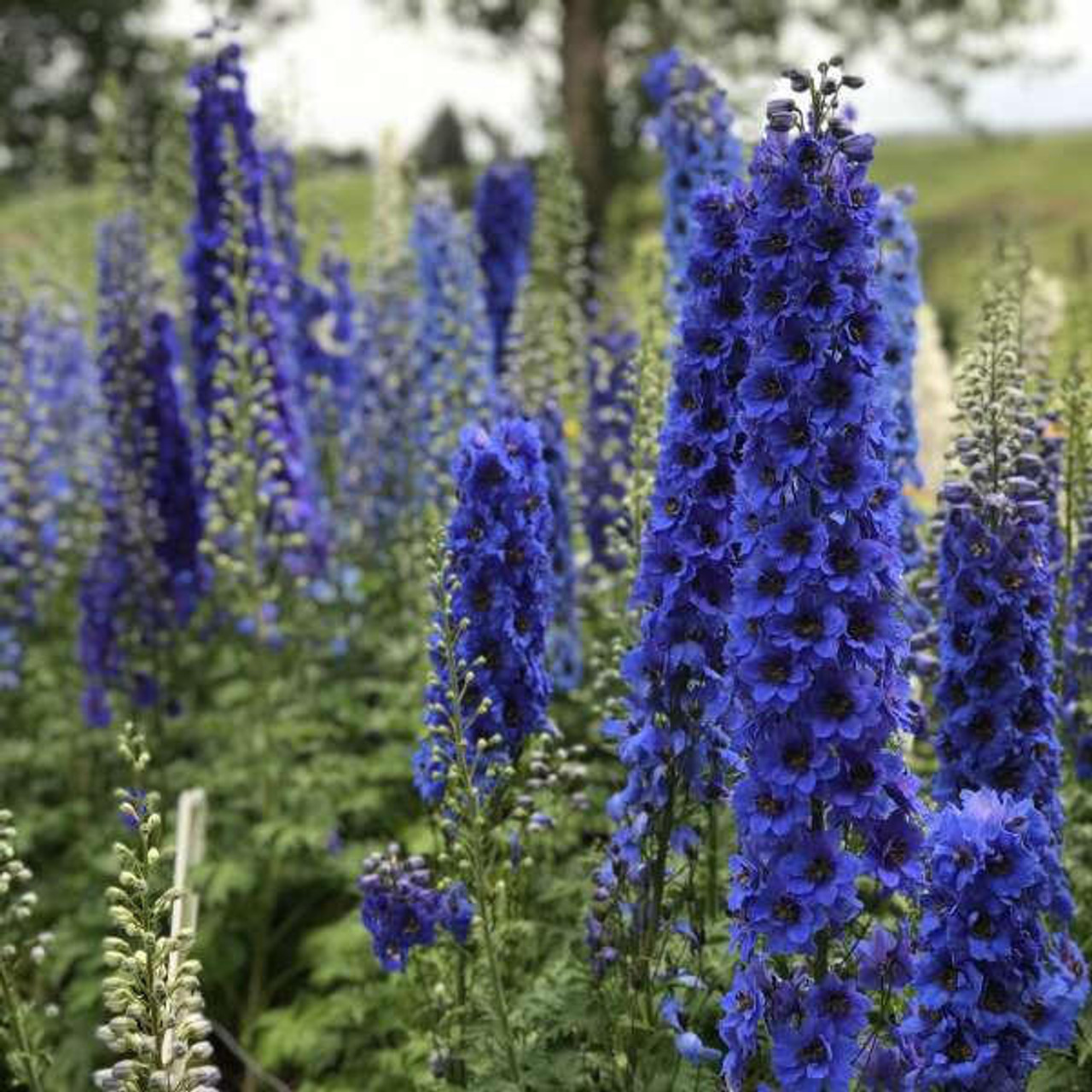Product Description
Delphinium 'Blue Buccaneers' (30)ct Flat
New Zealand Delphiniums
Common Name: Hybrid Bee Delphinium
Dark electric blue flowers hold black bees on strong flower spires. Since it is from seed, some lighter blues may appear. Compared to 'Cobalt Dreams', 'Blue Buccaneers' is more compact, has black bees, and has a more intense blue color.
Delphiniums are a classic garden perennial. These plants are excellent for adding height to small spaces. Their tall flower spikes are easily recognizable when they come into flower in summer. When in flower, the spikes of these plants become heavy and should be staked to avoid toppling over in rough weather, especially taller varieties. Newer hybrids are longer lived than some of the more traditional cultivars.
Delphiniums thrive in the cooler climates of the north country, though they will grow as far south as zone 7. The New Millenium hybrids, however, tend to be more tolerant of heat and humidity. They grow best in rich, well-drained soil with a basic pH. If your soil is naturally acidic, adding lime will help to provide these conditions. They are also heavy feeders. The addition of compost or manure to the soil as well the use of granular fertilizer will result in healthier, stronger plants.
Delphiniums can be grown in full sun or partial shade, though full sun may help to prevent powdery mildew. When planting, be sure to set the crown at or above soil level to avoid rot. Since their stems are hollow, taller varieties of Delphiniums should be staked to prevent damage from wind and rain. These new hybrids tend to be longer lived than their short-lived cousins but may be propagated from basal cuttings.
Height: 3.0-5.0 Feet
Spread: 1.5-2.0 Feet
Hardiness Zones: 3,4,5,6,7
Flower Color: Blue shades
Foliage Color: Green shades
Full Sun to Part Shade
Average Water Needs
Average to Fertile Soil Quality
Bloomtime: Early Summer, Late Summer, Early Fall
Attracts Butterflies and Hummingbirds
Bee Friendly
Deer and Rabbit Resistant
Seasonal Interest: Dried Seed Heads
Growth Rate: Medium
Border Plant, Cut Flower, Dried Flower, Mass Planting, Specimen, Focal Point
The Delphinium 'Blue Buccaneers' is a stunning perennial flower that boasts striking, electric blue blossoms. This variety is a New Millennium hybrid delphinium, bred in New Zealand for its impressive height, strong stems, and long blooming season . It is a favorite among gardeners for its vibrant color and ability to attract pollinators like butterflies and hummingbirds . The name "delphinium" originates from the Greek word "delphis," meaning dolphin, as the individual flowers resemble a dolphin's nose.
Delphinium 'Blue Buccaneers' is a standout plant with its electric blue flowers, each with a dark eye in the center . It typically grows 3 to 5 feet tall with a spread of 18 to 24 inches . The strong stems hold up the large flower spikes, which bloom from early summer to fall . This hybrid delphinium is known for its compact form and excellent cold hardiness . It is also deer and rabbit resistant, making it a great choice for gardens frequented by these animals . Unlike classic delphiniums that decline after a few years, the New Millennium hybrids, including 'Blue Buccaneers', can return for several seasons . This variety was developed by Jelitto Perennial Seeds.
One of the key advantages of 'Blue Buccaneers' is its enhanced tolerance to heat and humidity compared to older delphinium varieties . This makes it a suitable choice for a wider range of climates. Additionally, 'Blue Buccaneers' has a longer blooming season than older delphinium varieties, providing an extended period of vibrant color in the garden.
Growing Conditions Delphinium 'Blue Buccaneers' thrives in full sun to partial shade . It prefers well-drained soil that is rich in organic matter . While it can tolerate some shade, full sun can help prevent powdery mildew . The plant prefers a slightly alkaline soil pH, so adding lime to acidic soil is recommended . It is also a heavy feeder, so enriching the soil with compost or manure and using granular fertilizer will help it grow healthy and strong . Delphiniums prefer moist, cool summers; they do not fare well in hot, dry weather or sudden wind or rain, which can knock them down.
Care
- Watering Delphinium 'Blue Buccaneers' needs regular watering, especially during the growing season . Water deeply and regularly, allowing the top 2-3 inches of soil to dry out between waterings . Avoid overhead watering, as this can promote fungal diseases . Using drip irrigation or soaker hoses can help keep the foliage dry and reduce the risk of pests and diseases.
- Fertilizing This delphinium is a heavy feeder and benefits from regular fertilization . Apply a balanced, granular fertilizer in early spring and then once a month until July . Once flower initiation occurs, use less nitrogen and more potassium and phosphorus.
- Staking Due to its tall flower spikes and hollow stems, Delphinium 'Blue Buccaneers' requires staking to prevent the stems from breaking or flopping over, especially in windy conditions . Use sturdy bamboo canes or metal poles and tie the flower spikes to them for support.
Other Care Tips
- Deadheading: Remove spent blooms regularly to encourage further flowering and a second bloom cycle later in the summer.
- Cutting back: After the first flowering, cut back the main stalk to encourage side shoots to bloom . In the fall, cut the plant back to the ground to promote new growth the following season.
- Winterizing: In the fall, cut all the top growth back to within 6 inches of the soil and mulch the crown and root zone with 4-5 inches of organic compost or finely shredded arborist chips . In the spring, brush the mulch off the crown as the new growth emerges.
Pests and Diseases Delphinium 'Blue Buccaneers' can be susceptible to certain pests and diseases. Here are some of the common ones:
Pests
- Aphids: These small insects are common pests that feed on plant sap, causing distorted growth and secreting a sticky substance called honeydew. Honeydew can lead to the growth of sooty mold, which can further damage the plant. To control aphids, you can use insecticidal soap, neem oil, or introduce natural predators like ladybugs.
- Cyclamen mites: These tiny creatures can be difficult to spot, but their damage is evident in stunted growth, distorted flowers, and curled or blistered leaves. They thrive in humid conditions and can be particularly problematic for delphiniums. Remove and destroy affected plants. For minor infestations, use a miticide or neem oil.
- Slugs and snails: These pests are notorious for their voracious appetites and can cause significant damage to delphiniums by feeding on leaves and tender shoots, leaving irregular holes and slimy trails. To control them, consider using diatomaceous earth, copper tape barriers, or slug pellets. Handpicking slugs and snails during damp evenings can also be effective.
Diseases
- Powdery mildew: This fungal disease is a common problem for delphiniums, especially in humid conditions. It appears as a white, powdery substance on the leaves, stems, and flower buds, which can eventually cause yellowing and distortion. To prevent powdery mildew, ensure good air circulation around your plants, avoid overhead watering, and consider using fungicides if necessary.
- Leaf spot: Several fungal and bacterial pathogens can cause leaf spot diseases in delphiniums.
- Crown rot: This fungal disease can be devastating to delphiniums, causing the base of the stem to rot and eventually leading to plant death. To prevent crown rot, ensure proper soil drainage and avoid overwatering.
Companion Plants Delphinium 'Blue Buccaneers' can be paired with various companion plants to enhance the beauty of your garden. Here are some suitable options:
| Companion Plant | Benefits/Characteristics |
| Gypsophila FESTIVAL STAR® | A low-growing, airy plant with delicate white flowers that provide a beautiful contrast to the bold blue delphiniums. |
| Heliopsis TUSCAN GOLD™ | A cheerful, sun-loving perennial with golden-yellow flowers that bloom for an extended period, complementing the blue hues of 'Blue Buccaneers'. |
| Lagerstroemia 'Dark Roast' | A compact crape myrtle with deep purple foliage and vibrant pink flowers that add a touch of elegance to the garden. |
| Leucanthemum 'Spun Silk' | A charming perennial with white, daisy-like flowers that create a soft and romantic look when planted alongside delphiniums. |
| Pennisetum 'Puppy Love' | A dwarf fountain grass with attractive foliage and fluffy flower plumes that add texture and movement to the garden. |
| Phlox 'Backlight' | A vibrant phlox variety with deep pink flowers that create a striking color combination with the blue delphiniums. |
| Phlox Volcano® Volcano® Lilac Splash | A unique phlox with lilac-colored flowers that have a darker eye, adding a touch of whimsy to the garden. |
| Heliopsis h. Sunstruck | A false sunflower with semi-double, golden-yellow flowers that provide a long-lasting display of color. |
| Pennisetum alopecuroides Hameln | A dwarf fountain grass with graceful, arching foliage and bottlebrush-like flower plumes that add a touch of elegance to the garden. |
| Calamintha nepeta var. Nepeta | A fragrant herb with lavender-pink flowers that attract pollinators and provide a lovely contrast to the blue delphiniums. |
Propagation Delphinium 'Blue Buccaneers' can be grown from seed. Approximately 350 seeds equal 1 gram . For best germination results, seeds need temperatures of +22°C [72°F] or more, and moderate, but constant humidity is very important. The best sowing date is anytime, but warmer temperatures are preferred.
Delphinium 'Blue Buccaneers' is a magnificent addition to any garden. Its vibrant blue flowers, tall stature, and exceptionally long blooming season make it a true showstopper. This New Millennium hybrid is also more tolerant of heat and humidity than older delphinium varieties, making it a versatile choice for various climates. By following the care tips outlined in this article, such as proper watering, fertilizing, and staking (due to its hollow stems), you can ensure that your 'Blue Buccaneers' delphinium thrives and brings beauty to your outdoor space for years to come. Don't forget to deadhead regularly to encourage more blooms and cut back the plant in the fall to promote new growth the following season.
Thirty (30) plants per flat (or tray). Approximate Plug Measurements: 3 inches deep x 2 inches wide.
Other Details
The most important part of the plant is its root system. Healthy roots are the foundation of a healthy, vibrant plant. The type of plug container used is based on the specific needs of the plants. Perennials offered as bare root traditionally perform better when planted as bare root.Planted in a specialized mix, potted plants have well established root systems. Top growth stage will vary depending on the current life cycle and time of year when shipped. In Winter and early Spring dormant plants may be shipped. Dormant plants may be planted right away, even before the last frost date.
Most bare root varieties are field grown for at least one season, though Hemerocallis and Hosta are grown for two seasons. The bulk of the soil is removed during the harvesting process and the tops of most varieties are trimmed back to the crown. They are graded, packed in shredded aspen or sphagnum moss and stored in freezers until ready to be shipped.
See our Container Sizes and Bare Root Perennials pages for more information.
Plant information and care is provided in the Overview section, Plant Genus Page and general information is provided in the Planting Care & Guides. Additional questions can be asked on each Plant page.
Plant Spacing: Using the maximum mature spread or width of a plant to guide spacing, ensures space to grow to full size. To fill an area sooner, plant them closer together. Just remember, future thinning or transplanting may be needed.
Water: Keep a close eye on newly planted perennials, especially throughout the first growing year. Most early plant loss is due to too much or too little water!







